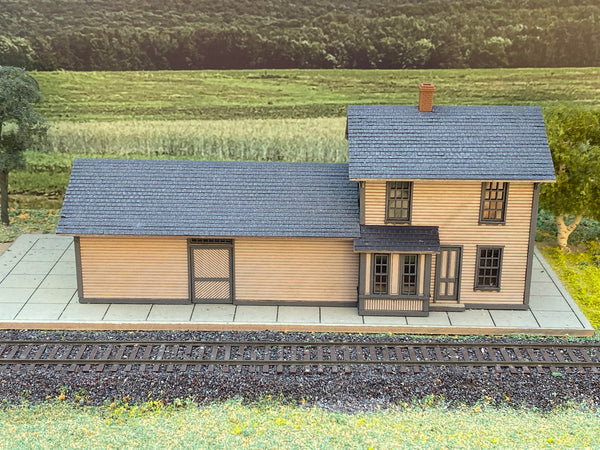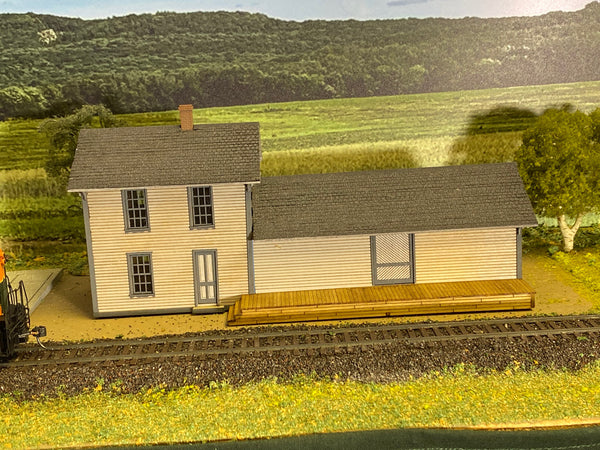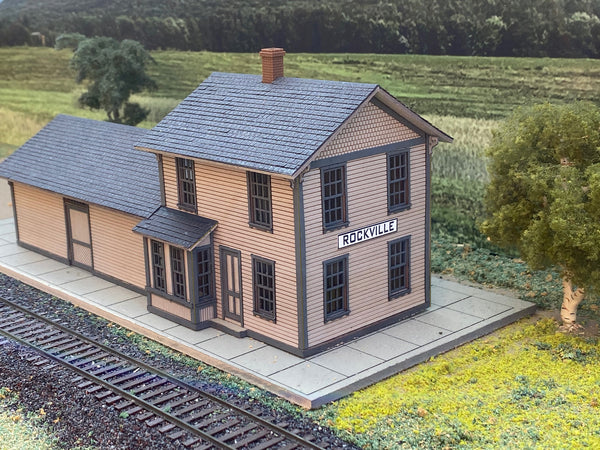Standard Two Story Combination Depot 1887, 20x64 - HO
The Great Northern Railway Historical Society Company Store is pleased to offer an HO scale kit of the 20’ x 64’ two-story 1887 standard plan combination passenger and freight depot. Using blueprints from our archives at Jackson Street Roundhouse, the kit is custom made for you by Hidden River Manufacturing.
The St. Paul & Pacific built its first two story-depot as early as 1872. Great Northern predecessor St. Paul, Minneapolis & Manitoba built several depots to this design during 1887, the only year they were built. Subsequent two-story designs were 24 feet wide. Researcher Harold Hall has located 35 two-story depots at 36 locations across the system.
These depots were placed at locations then on the fringe of civilization where housing for the station agent and his family was not likely to be available. The vast majority were built in Dakota Territory, with some in Minnesota. The Assiniboine, Montana, depot was moved to Box Elder, Montana, in 1911.
This kit features: exterior and interior walls, flooring, removable roof with soffit, and interior details that are 100 percent laser-cut from quality basswood and aircraft grade 3-ply birch plywood with custom laser-scribed siding with eave laser cut decorative shingles; individual 3-tabbed style roofing shingle strips; the 1887 depot design’s hallmark bay window with two bay front windows; laser-cut peel & stick doors, windows with glazing, and trim – all that assemble with ease; injection molded chimney; and clear concise illustrated instructions.
This HO model assembled is 8-3/4” long and 3-1/8” wide over the bay window. With the included optional raised back loading platform, the full width is 4-1/4”. The kit features a raised interior freight room floor with a ramp leading to the front loading freight door. 36 sets of station sign boards are included for the various Great Northern stations using this style depot. No front platform is included.
Reference Sheet No. 154 provides historical information about this depot design, including a list of stations where they were built.
DEPOT COLORS
The Great Northern Railway changed its paint scheme for wooden buildings, including depots, from time to time. This makes the color of frame buildings a clue to the time frame you are modeling.
Starting before 1900 depots were painted entirely mineral red. In 1909 new frame depots were painted medium yellow-buff on large wall sections with a darker olive-green trim on windows and doors, belt rails and corner posts. Older depots were repainted into the new colors when they required it. In September of 1930, the two-tone gray scheme of light gray on the main structure and darker gray trim on windows, doors, belt rails and corner posts was introduced. Again, existing depots were repainted as required. The gray was followed after 1950 by white as the main color with green trim on windows, doors, belt rails and corner posts. Photos taken in the middle and late 1960s show many depots painted all white with green trim only on windows. A few of the two-tone gray depots were never repainted until after the BN merger. Station name boards were always white with black lettering and black trim along the edges.
See RS 35, RS 53, 154, RS 397, and RS 402.
Explanatory notes:
Note 1: No evidence has been found in AFE or corporate files for dark green or red trim, on early mineral red depots. All reference to dark green or red trim is anecdotal and not supported by any documents, but some think it is consistent with available black and white photos.
Note 2: The change to yellow-buff with olive green trim was made official with the new 1909 depot style featuring belt rails, boxed eaves, angled bay, and different siding widths above and below the belt.
Note 3: In Reference Sheet 402 the term “yellow-buff” was used, rather than the yellow-ochre of RS 53 which called the depot trim a “darker ochre.” That term is very confusing and not at all descriptive of a color with a definite green cast. There was some confusion among GNRHS members about these colors when these ochre descriptions were written in the 1970s.
Note 4: Existing “old-style” depots continued in service after 1909. It took time for existing depots to be painted in the new colors; some never were, but went directly to two-tone gray sometime after September, 1930, when that standard was introduced.
Note 5: Actual boards collected from several depots now exist in the JSRH Archives in St. Paul. These boards have colors consistent with the colors as described here. The colors stated here are also confirmed in documents and corporate files located at JSRH and Minnesota History Museum. Martin Evoy’s extensive files preserved at JSRH have also been carefully examined, as well as paint chips collected by Martin and others.
Note 6: A few depots located on the branch between Alexandria, MN and St. Cloud, MN are thought to have been painted gray with mineral red trim. Examination of paint layers on the boards in the depot in Dalton, MN supports this.








